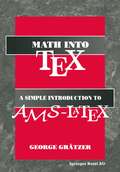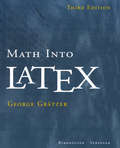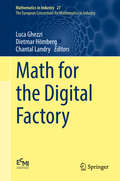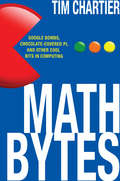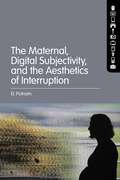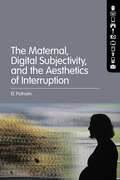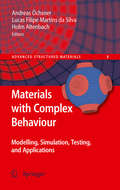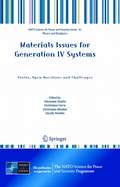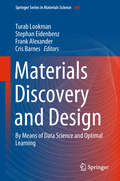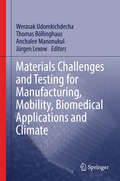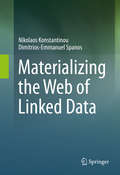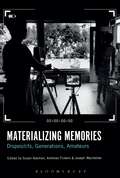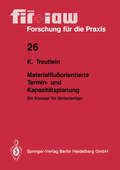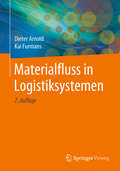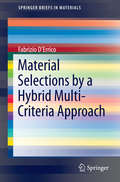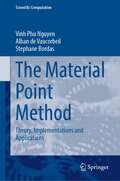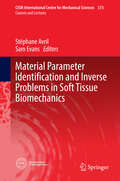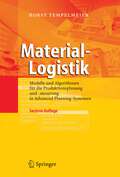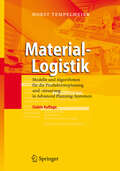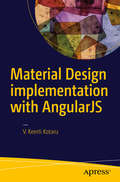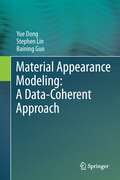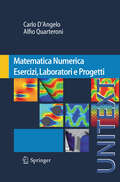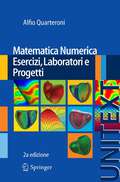- Table View
- List View
Math into LaTeX
by George GrätzerA new chapter "A Visual Introduction to MikTeX," an open source implementation of TeX and LaTeX for Windows operating systems Another new chapter describing amsrefs, a simpler method for formatting references that incorporates and replaces BibTeX data Integrates a major revision to the amsart document class, along with updated examples
Math for the Digital Factory: Weierstrass Institute, Berlin, May 7-9 2014 (Mathematics in Industry #27)
by Luca Ghezzi Dietmar Hömberg Chantal LandryThis volume provides a unique collection of mathematical tools and industrial case studies in digital manufacturing. It addresses various topics, ranging from models of single production technologies, production lines, logistics and workflows to models and optimization strategies for energy consumption in production. The digital factory represents a network of digital models and simulation and 3D visualization methods for the holistic planning, realization, control and ongoing improvement of all factory processes related to a specific product. In the past ten years, all industrialized countries have launched initiatives to realize this vision, sometimes also referred to as Industry 4.0 (in Europe) or Smart Manufacturing (in the United States). Its main goals are • reconfigurable, adaptive and evolving factories capable of small-scale production • high-performance production, combining flexibility, productivity, precision and zero defects • energy and resource efficiency in manufacturing None of these goals can be achieved without a thorough modeling of all aspects of manufacturing together with a multi-scale simulation and optimization of process chains; in other words, without mathematics. To foster collaboration between mathematics and industry in this area the European Consortium for Mathematics in Industry (ECMI) founded a special interest group on Math for the Digital Factory (M4DiFa). This book compiles a selection of review papers from the M4DiFa kick-off meeting held at the Weierstrass Institute for Applied Analysis and Stochastics in Berlin, Germany, in May 2014. The workshop aimed at bringing together mathematicians working on modeling, simulation and optimization with researchers and practitioners from the manufacturing industry to develop a holistic mathematical view on digital manufacturing. This book is of interest to practitioners from industry who want to learn about important mathematical concepts, as well as to scientists who want to find out about an exciting new area of application that is of vital importance for today’s highly industrialized and high-wage countries.
Math Bytes: Google Bombs, Chocolate-Covered Pi, and Other Cool Bits in Computing
by Tim ChartierThis book provides a fun, hands-on approach to learning how mathematics and computing relate to the world around us and help us to better understand it. How can reposting on Twitter kill a movie's opening weekend? How can you use mathematics to find your celebrity look-alike? What is Homer Simpson’s method for disproving Fermat’s Last Theorem? Each topic in this refreshingly inviting book illustrates a famous mathematical algorithm or result--such as Google’s PageRank and the traveling salesman problem--and the applications grow more challenging as you progress through the chapters. But don’t worry, helpful solutions are provided each step of the way.Math Bytes shows you how to do calculus using a bag of chocolate chips, and how to prove the Euler characteristic simply by doodling. Generously illustrated in color throughout, this lively and entertaining book also explains how to create fractal landscapes with a roll of the dice, pick a competitive bracket for March Madness, decipher the math that makes it possible to resize a computer font or launch an Angry Bird--and much, much more. All of the applications are presented in an accessible and engaging way, enabling beginners and advanced readers alike to learn and explore at their own pace--a bit and a byte at a time.
Math Bytes: Google Bombs, Chocolate-Covered Pi, and Other Cool Bits in Computing
by Tim ChartierThis book provides a fun, hands-on approach to learning how mathematics and computing relate to the world around us and help us to better understand it. How can reposting on Twitter kill a movie's opening weekend? How can you use mathematics to find your celebrity look-alike? What is Homer Simpson’s method for disproving Fermat’s Last Theorem? Each topic in this refreshingly inviting book illustrates a famous mathematical algorithm or result--such as Google’s PageRank and the traveling salesman problem--and the applications grow more challenging as you progress through the chapters. But don’t worry, helpful solutions are provided each step of the way.Math Bytes shows you how to do calculus using a bag of chocolate chips, and how to prove the Euler characteristic simply by doodling. Generously illustrated in color throughout, this lively and entertaining book also explains how to create fractal landscapes with a roll of the dice, pick a competitive bracket for March Madness, decipher the math that makes it possible to resize a computer font or launch an Angry Bird--and much, much more. All of the applications are presented in an accessible and engaging way, enabling beginners and advanced readers alike to learn and explore at their own pace--a bit and a byte at a time.
The Maternal, Digital Subjectivity, and the Aesthetics of Interruption
by EL PutnamBringing together philosophies of the maternal with digital technology may appear to be an arbitrary pairing. However, reading them intertextually through select creative practices reveals how both encompass an aesthetics of interruption that becomes a novel means of understanding subjectivity.EL Putnam investigates how the digital performances of certain artists, creators, and technologists rupture existing representations of the maternal, taking advantage of the formal properties of digital media. What results are interruptions of visual and aural constructions through an immanent merging of the performing body with digital technologies.Putnam bases her analysis on close examinations of the way certain makers use the formal properties of digital imagery, such as the gap, the glitch, and the lag, as means of rendering images of the maternal uncanny in order to challenge mediation, constituting an aesthetics of interruption. The result is a radical critical strategy for engaging with digital technology and subsequent understandings of the subject that defy current modes of assimilation.
The Maternal, Digital Subjectivity, and the Aesthetics of Interruption
by EL PutnamBringing together philosophies of the maternal with digital technology may appear to be an arbitrary pairing. However, reading them intertextually through select creative practices reveals how both encompass an aesthetics of interruption that becomes a novel means of understanding subjectivity.EL Putnam investigates how the digital performances of certain artists, creators, and technologists rupture existing representations of the maternal, taking advantage of the formal properties of digital media. What results are interruptions of visual and aural constructions through an immanent merging of the performing body with digital technologies.Putnam bases her analysis on close examinations of the way certain makers use the formal properties of digital imagery, such as the gap, the glitch, and the lag, as means of rendering images of the maternal uncanny in order to challenge mediation, constituting an aesthetics of interruption. The result is a radical critical strategy for engaging with digital technology and subsequent understandings of the subject that defy current modes of assimilation.
Materials with Complex Behaviour: Modelling, Simulation, Testing, and Applications (Advanced Structured Materials #3)
by Andreas Öchsner Lucas Filipe Martins Silva Holm AltenbachCommon engineering materials reach in many demanding applications such as automotive or aerospace their limits and new developments are required to ful ll increasing demands on performance and characteristics. The properties of ma- rials can be increased for example by combining different materials to achieve better properties than a single constituent or by shaping the material or c- stituents in a speci c structure. Many of these new materials reveal a much more complex behavior than traditional engineering materials due to their advanced str- ture or composition. Furthermore, the classical applications of many engineering materials are extended to new ranges of applications and to more demanding en- ronmental conditions such as elevated temperatures. All these tendencies require in addition to the synthesis of new materials, proper methods for their m- ufacturing and extensive programs for their characterization. In many elds of application, the development of new methods and processes must be acc- plished by accurate and reliable modeling and simulation techniques. Only the interaction between these new developments with regards to manufacturing, m- eling, characterization, further processing and monitoring of materials will allow to meet all demands and to introduce these developments in safety-relevant applications. The 3rd International Conference on Advanced Computational Engineering and Experimenting, ACE-X 2009, was held in Rome, Italy, from 22 to 23 June 2009 with a strong focus on the above mentioned developments.
Materials Issues for Generation IV Systems: Status, Open Questions and Challenges (NATO Science for Peace and Security Series B: Physics and Biophysics)
by Véronique Ghetta Dominique Gorse Dominique Mazière Vassilis PontikisGlobal warming, shortage of low-cost oil resources and the increasing demand for energy are currently controlling the world's economic expansion while often opposing desires for sustainable and peaceful development. In this context, atomic energy satisfactorily fulfills the criteria of low carbon gas production and high overall yield. However, in the absence of industrial fast-breeders the use of nuclear fuel is not optimal, and the production of high activity waste materials is at a maximum. These are the principal reasons for the development of a new, fourth generation of nuclear reactors, minimizing the undesirable side-effects of current nuclear energy production technology while increasing yields by increasing operation temperatures and opening the way for the industrial production of hydrogen through the decomposition of water. The construction and use of such reactors is hindered by several factors, including performance limitations of known structural materials, particularly if the life of the projected systems had to extend over the periods necessary to achieve low costs (at least 60 years). This book collects lectures and seminars presented at the homonymous NATO ASI held in autumn 2007 at the Institut d’Etudes Scientifiques in Cargèse, France. The adopted approach aims at improving and coordinating basic knowledge in materials science and engineering with specific areas of condensed matter physics, the physics of particle/matter interaction and of radiation damage. It is our belief that this methodology is crucially conditioning the development and the industrial production of new structural materials capable of coping with the requirements of these future reactors.
Materials Discovery and Design: By Means of Data Science and Optimal Learning (Springer Series in Materials Science #280)
by Turab Lookman Stephan Eidenbenz Frank Alexander Cris BarnesThis book addresses the current status, challenges and future directions of data-driven materials discovery and design. It presents the analysis and learning from data as a key theme in many science and cyber related applications. The challenging open questions as well as future directions in the application of data science to materials problems are sketched. Computational and experimental facilities today generate vast amounts of data at an unprecedented rate. The book gives guidance to discover new knowledge that enables materials innovation to address grand challenges in energy, environment and security, the clearer link needed between the data from these facilities and the theory and underlying science. The role of inference and optimization methods in distilling the data and constraining predictions using insights and results from theory is key to achieving the desired goals of real time analysis and feedback. Thus, the importance of this book lies in emphasizing that the full value of knowledge driven discovery using data can only be realized by integrating statistical and information sciences with materials science, which is increasingly dependent on high throughput and large scale computational and experimental data gathering efforts. This is especially the case as we enter a new era of big data in materials science with the planning of future experimental facilities such as the Linac Coherent Light Source at Stanford (LCLS-II), the European X-ray Free Electron Laser (EXFEL) and MaRIE (Matter Radiation in Extremes), the signature concept facility from Los Alamos National Laboratory. These facilities are expected to generate hundreds of terabytes to several petabytes of in situ spatially and temporally resolved data per sample. The questions that then arise include how we can learn from the data to accelerate the processing and analysis of reconstructed microstructure, rapidly map spatially resolved properties from high throughput data, devise diagnostics for pattern detection, and guide experiments towards desired targeted properties. The authors are an interdisciplinary group of leading experts who bring the excitement of the nascent and rapidly emerging field of materials informatics to the reader.
Materials Challenges and Testing for Manufacturing, Mobility, Biomedical Applications and Climate
by Werasak Udomkichdecha Thomas Böllinghaus Jürgen Lexow Anchalee ManonukulIn two parts, the book focusses on materials science developments in the area of1) Materials Data and Informatics: - Materials data quality and infrastructure - Materials databases - Materials data mining, image analysis, data driven materials discovery, data visualization. 2) Materials for Tomorrow’s Energy Infrastructure: - Pipeline, transport and storage materials for future fuels: biofuels, hydrogen, natural gas, ethanol, etc. -Materials for renewable energy technologiesThis book presents selected contributions of exceptional young postdoctoral scientists to the 4th WMRIF Workshop for Young Scientists, hosted by the National Institute of Standards and Technology, at the NIST site in Boulder, Colorado, USA, September 8 to September 10, 2014.
Materializing the Web of Linked Data
by Nikolaos Konstantinou Dimitrios-Emmanuel SpanosThis book explains the Linked Data domain by adopting a bottom-up approach: it introduces the fundamental Semantic Web technologies and building blocks, which are then combined into methodologies and end-to-end examples for publishing datasets as Linked Data, and use cases that harness scholarly information and sensor data. It presents how Linked Data is used for web-scale data integration, information management and search. Special emphasis is given to the publication of Linked Data from relational databases as well as from real-time sensor data streams. The authors also trace the transformation from the document-based World Wide Web into a Web of Data. Materializing the Web of Linked Data is addressed to researchers and professionals studying software technologies, tools and approaches that drive the Linked Data ecosystem, and the Web in general.
Materializing Memories: Dispositifs, Generations, Amateurs
by Andreas Fickers Susan Aasman Joseph WachelderA multitude of devices and technological tools now exist to make, share, and store memories and moments with family, friends, and even strangers. Memory practices such as home movies, which originated as the privilege of a few, well-to-do families, have now emerged as ubiquitous and immediate cultures of sharing. Departing from the history of home movies, this volume offers a sophisticated understanding of technologically mediated, mostly ritualized memory practices, from early beginnings in the fin-de-siècle to today.Departing from a longue durée perspective on home movie practices, Materializing Memories moves beyond a strict historical study to grapple with highly theorized fields, such as media studies, memory studies, and science and technology studies (STS). The contributors to this volume reflect on these different intellectual backgrounds and perspectives, but all chapters share a common framework by addressing practices of use, user configurations, and relevant media landscapes. Grasping the cultural dynamics of such multi-faceted practices requires a multidimensional conceptual approach, here achieved by centering around three concepts as central analytical lenses: dispositifs, generations, and amateurs.
Materializing Memories: Dispositifs, Generations, Amateurs
by Andreas Fickers Susan Aasman Joseph WachelderA multitude of devices and technological tools now exist to make, share, and store memories and moments with family, friends, and even strangers. Memory practices such as home movies, which originated as the privilege of a few, well-to-do families, have now emerged as ubiquitous and immediate cultures of sharing. Departing from the history of home movies, this volume offers a sophisticated understanding of technologically mediated, mostly ritualized memory practices, from early beginnings in the fin-de-siècle to today.Departing from a longue durée perspective on home movie practices, Materializing Memories moves beyond a strict historical study to grapple with highly theorized fields, such as media studies, memory studies, and science and technology studies (STS). The contributors to this volume reflect on these different intellectual backgrounds and perspectives, but all chapters share a common framework by addressing practices of use, user configurations, and relevant media landscapes. Grasping the cultural dynamics of such multi-faceted practices requires a multidimensional conceptual approach, here achieved by centering around three concepts as central analytical lenses: dispositifs, generations, and amateurs.
Materialflußorientierte Termin- und Kapazitätsplanung: Ein Konzept für Serienfertiger (fir+iaw Forschung für die Praxis #26)
by Klaus TreutleinMaterialfluss in Logistiksystemen
by Dieter Arnold Kai FurmansDas Basiswerk bietet mit den folgenden Themen einen umfassenden Einblick in die komplexen Zusammenhänge moderner Materialflusssysteme: Grundelemente und Abbildung von Materialflusssystemen, Warten und Bedienen im Materialfluss, Lagern und Kommissionieren, Sortieren, Planung von Materialflusssystemen sowie Informationsflüsse in Logistiksystemen. Dieses Fachbuch wendet sich an Ingenieure des Maschinenbaus, der Produktionstechnik und des Wirtschaftsingenieurwesens.
Material Selections by a Hybrid Multi-Criteria Approach (SpringerBriefs in Materials)
by Fabrizio D’ErricoThis Brief presents a new method that is based on the author and his students’ shared experience in applying a structured procedure that has as its main goal the creation of a material selection technique that uses language and employs a platform that is not restricted to engineers. Based on a hybrid approach that exploits both traditional and semi-quantitative concepts, it moves forward step-by step, and uses a platform based on a Quality Function Deployment matrix framework. Candidate materials are screened out and finally assessed by two user-friendly graphic analysis tools, one based on the value curve of the product and the other on an original Bubble Maps tool. The Brief is written for all those whose aim is for a better understanding of how to integrate and speed up the entire product development process from the initial product concept and engineering design phases to design specs, manufacturability and product marketing with optimal choice of materials.
The Material Point Method: Theory, Implementations and Applications (Scientific Computation)
by Vinh Phu Nguyen Alban de Vaucorbeil Stephane BordasThis book provides an introduction to the fundamental theory, practical implementation, and core and emerging applications of the material point method (MPM) and its variants. The MPM combines the advantages of both finite element analysis (FEM) and meshless/meshfree methods (MMs) by representing the material by a set of particles overlaid on a background mesh that serves as a computational scratchpad.The book shows how MPM allows a robust, accurate, and efficient simulation of a wide variety of material behaviors without requiring overly complex implementations. MPM and its variants have been shown to be successful in simulating a large number of high deformation and complicated engineering problems such as densification of foam, sea ice dynamics, landslides, and energetic device explosions, to name a few, and have recently found applications in the movie industry. It is hoped that this comprehensive exposition on MPM variants and their applications will not only provide an opportunity to re-examine previous contributions, but also to re-organize them in a coherent fashion and in anticipation of new advances.Sample algorithms for the solutions of benchmark problems are provided online so that researchers and graduate students can modify these algorithms and develop their own solution algorithms for specific problems. The goal of this book is to provide students and researchers with a theoretical and practical knowledge of the material point method to analyze engineering problems, and it may help initiate and promote further in-depth studies on the subjects discussed.
Material Parameter Identification and Inverse Problems in Soft Tissue Biomechanics (CISM International Centre for Mechanical Sciences #573)
by Stéphane Avril Sam EvansThe articles in this book review hybrid experimental-computational methods applied to soft tissues which have been developed by worldwide specialists in the field. People developing computational models of soft tissues and organs will find solutions for calibrating the material parameters of their models; people performing tests on soft tissues will learn what to extract from the data and how to use these data for their models and people worried about the complexity of the biomechanical behavior of soft tissues will find relevant approaches to address this complexity.
Material-Logistik: Modelle und Algorithmen für die Produktionsplanung und -steuerung in Advanced Planning-Systemen
by Horst TempelmeierDas Buch vermittelt einen umfassenden Überblick über Modelle und Algorithmen zur dynamischen Losgrößenoptimierung für ein- und mehrstufige Erzeugnisstrukturen, die eingehend erläutert und anhand zahlreicher Beispiele veranschaulicht werden. Außerdem werden Verfahren zur optimalen Bestellmengenplanung und Lieferantenauswahl unter Beachtung von Mengenrabatten dargestellt. Weiterhin werden die Prognoseverfahren, die in zahlreichen Advanced Planning-Systemen implementiert sind, detailliert erläutert. Schließlich wird gezeigt, wie die dargestellten Prognose- und Planungskonzepte in den SAP-Systemen mySAP SCM (APO) und R/3 umgesetzt werden.
Material-Logistik: Modelle und Algorithmen für die Produktionsplanung und -steuerung in Advanced Planning-Systemen
by Horst TempelmeierDas Buch vermittelt einen umfassenden Überblick über Modelle und Algorithmen zur dynamischen Losgrößenoptimierung für ein- und mehrstufige Erzeugnisstrukturen, die eingehend erläutert und anhand zahlreicher Beispiele veranschaulicht werden. Außerdem werden Verfahren zur optimalen Bestellmengenplanung und Lieferantenauswahl unter Beachtung von Mengenrabatten dargestellt. Weiterhin werden die Prognoseverfahren, die in zahlreichen Advanced Planning-Systemen implementiert sind, detailliert erläutert. Schließlich wird gezeigt, wie die dargestellten Prognose- und Planungskonzepte in den SAP-Systemen mySAP SCM (APO) und R/3 umgesetzt werden. Gegenüber der sechsten Auflage wurden erhebliche Veränderungen vorgenommen. So wird nun unterschieden zwischen Mikroperiodenmodellen und Makroperiodenmodellen zur dynamischen Losgrößenplanung mit der Folge, dass der Abschnitt zur Losgrößenplanung entsprechend umgestellt und beträchtlich ausgeweitet werden musste. Das Buch richtet sich an Studierende der Betriebswirtschaftslehre sowie des Wirtschaftsingenieurwesens und der Wirtschaftsinformatik, aber auch an interessierte Praktiker, die in ihrem beruflichen Umfeld mit Produktionsplanung und -steuerung, Advanced Planning-Systemen oder Logistik bzw. Supply Chain Management zu tun haben.
Material Design Implementation with AngularJS: UI Component Framework
by V. Keerti KotaruBuild high-quality web and mobile user interfaces (UI) that are interactive, fluid, and provide a consistent experience across devices from desktops to tablets to smartphones.Use a Material Design approach to position elements and create animations along with principles of the sophisticated AngularJS JavaScript framework. Take advantage of Angular Material, a UI component framework that works out of the box to design web pages that adapt to various screen sizes and adhere to Material Design specifications.What You Will Learn:Develop a UI that adheres to Material Design principles using Angular Material, a UI component frameworkUse various Angular Material elements, directives, and services in conjunction with CSS3 Flexbox for layout managementUse best practice design techniques to develop a responsive UI to fit multiple devices and screen sizes from desktop to tablet to mobile phoneDevelop web apps for both mobile and desktop form factors and screen sizes using HTML, CSS, and JavaScriptWho This Book Is For:Web and mobile app developers with a basic understanding of JavaScript, HTML, and CSS
Material Appearance Modeling: A Data-Coherent Approach
by Yue Dong Stephen Lin Baining GuoA principal aim of computer graphics is to generate images that look as real as photographs. Realistic computer graphics imagery has however proven to be quite challenging to produce, since the appearance of materials arises from complicated physical processes that are difficult to analytically model and simulate, and image-based modeling of real material samples is often impractical due to the high-dimensional space of appearance data that needs to be acquired.This book presents a general framework based on the inherent coherency in the appearance data of materials to make image-based appearance modeling more tractable. We observe that this coherence manifests itself as low-dimensional structure in the appearance data, and by identifying this structure we can take advantage of it to simplify the major processes in the appearance modeling pipeline. This framework consists of two key components, namely the coherence structure and the accompanying reconstruction method to fully recover the low-dimensional appearance data from sparse measurements. Our investigation of appearance coherency has led to three major forms of low-dimensional coherence structure and three types of coherency-based reconstruction upon which our framework is built.This coherence-based approach can be comprehensively applied to all the major elements of image-based appearance modeling, from data acquisition of real material samples to user-assisted modeling from a photograph, from synthesis of volumes to editing of material properties, and from efficient rendering algorithms to physical fabrication of objects. In this book we present several techniques built on this coherency framework to handle various appearance modeling tasks both for surface reflections and subsurface scattering, the two primary physical components that generate material appearance. We believe that coherency-based appearance modeling will make it easier and more feasible for practitioners to bring computer graphics imagery to life.This book is aimed towards readers with an interest in computer graphics. In particular, researchers, practitioners and students will benefit from this book by learning about the underlying coherence in appearance structure and how it can be utilized to improve appearance modeling. The specific techniques presented in our manuscript can be of value to anyone who wishes to elevate the realism of their computer graphics imagery. For understanding this book, an elementary background in computer graphics is assumed, such as from an introductory college course or from practical experience with computer graphics.
Matematica Numerica Esercizi, Laboratori e Progetti (UNITEXT)
by Carlo D'Angelo Alfio QuarteroniLa Matematica Numerica è una disciplina che si sviluppa in simbiosi con il calcolatore. Questo testo propone, oltre a richiami degli argomenti fondamentali, sia Esercizi teorici da risolvere "con carta e penna'', atti a far comprendere meglio al lettore la teoria, sia Laboratori, in cui per un dato problema si debbono scegliere gli algoritmi più adatti, realizzare un programma in linguaggio Matlab per la loro implementazione, infine rappresentare, interpretare ed analizzare alla luce della teoria i risultati numerici. Per ogni Esercizio ed ogni Laboratorio si presenta una risoluzione dettagliata, completata da una ampia discussione critica. Il testo contiene infine alcuni Progetti, riguardanti il primo gli algoritmi di page ranking dei moderni motori di ricerca, il secondo la determinazione del campo elettrico fra due conduttori, il terzo alcuni sistemi dinamici oscillanti di grande rilevanza in applicazioni elettroniche e biologiche.
Matematica Numerica Esercizi, Laboratori e Progetti (UNITEXT #75)
by Alfio QuarteroniLa Matematica Numerica una disciplina che si sviluppa in simbiosi con il calcolatore; essa fa uso di linguaggi di programmazione che consentono di tradurre gli algoritmi in programmi eseguibili. Questo testo si propone di aiutare lo studente nella transizione fra i concetti teorici e metodologici della Matematica Numerica e la loro implementazione al computer. A questo scopo vengono proposti Esercizi teorici da risolvere con carta e penna atti a far comprendere meglio al lettore la teoria, e Laboratori, in cui per un dato problema si debbono scegliere gli algoritmi pi adatti, realizzare un programma in linguaggio MATLAB per la loro implementazione, rappresentare graficamente in maniera idonea i risultati ottenuti dal calcolatore, infine interpretarli ed analizzarli alla luce della teoria. Per ogni Esercizio ed ogni Laboratorio si presenta una risoluzione dettagliata,completata da una ampia discussione critica. Per una migliore fruizione degli argomenti sviluppati, il testo si apre con una introduzione allambiente di programmazione MATLAB. Il testo contiene infine alcuni Progetti. Il primo concerne gli algoritmi di page ranking dei moderni motori di ricerca, il secondo la determinazione del campo elettrico fra due conduttori e il calcolo della capacit di un condensatore, il terzo lo studio di sistemi dinamici oscillanti di grande rilevanza in applicazioni elettroniche e biologiche. Il testo rivolto a studenti dei corsi di laurea in Matematica, Ingegneria, Fisica e Informatica. La seconda edizione stata arricchita con numerosi nuovi Esercizi e Progetti.
